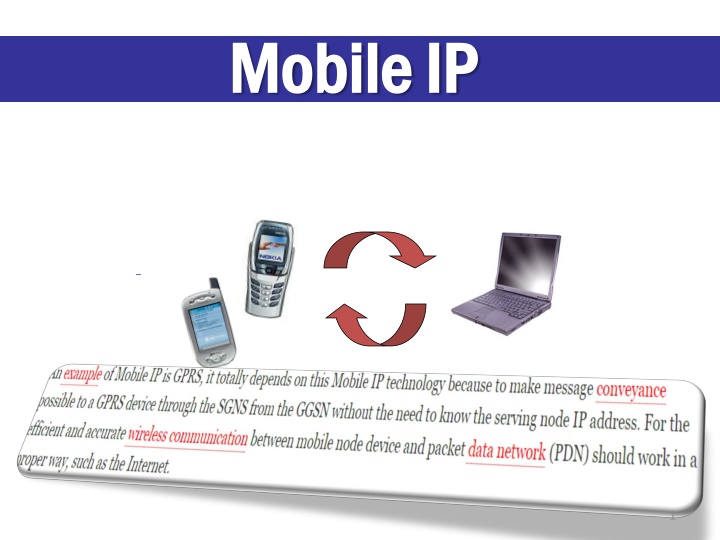
Significance of Mobile IP in Internet Connectivity
Learn about Mobile IP (MIP), a protocol by the Internet Engineering Task Force (IETF) allowing seamless movement of mobile devices between networks while maintaining a fixed IP address. Explore its applications, operational principles, key definitions, and scenarios. Discover how Mobile IP ensures continuous internet connectivity for users in wired and wireless environments, supporting host mobility without changing IP addresses.
Download Presentation

Please find below an Image/Link to download the presentation.
The content on the website is provided AS IS for your information and personal use only. It may not be sold, licensed, or shared on other websites without obtaining consent from the author. If you encounter any issues during the download, it is possible that the publisher has removed the file from their server.
You are allowed to download the files provided on this website for personal or commercial use, subject to the condition that they are used lawfully. All files are the property of their respective owners.
The content on the website is provided AS IS for your information and personal use only. It may not be sold, licensed, or shared on other websites without obtaining consent from the author.
E N D
Presentation Transcript
Mobile IP Mobile IP Nokia 6800 1
What is Mobile IP? Mobile IP (or MIP) is an Internet Engineering Task Force (IETF) standard communications protocol that is designed to allow mobile device users to move from one network to another while maintaining a permanent IP address. Mobile IP stands for Mobile Internet Protocol A wireless connection to the Internet Designed to support host mobility Stay connected regardless of location without changing IP address 2
Mobile IP Applications In many applications (e.g., VPN, VoIP), sudden changes in network connectivity and IP address can cause problems. Mobile IP was designed to support seamless and continuous Internet connectivity. Mobile IP is most often found in wired and wireless environments where users need to carry their mobile devices across multiple LAN subnets. Examples of use are in roaming between overlapping wireless systems, e.g., IP over DVB, WLAN, WiMAX and BWA . Mobile IP is not required within cellular systems such as 3G, to provide transparency when Internet users migrate between cellular towers, since these systems provide their own data link layer handover and roaming mechanisms. However, it is often used in 3G systems to allow seamless IP mobility between different packet data serving node (PDSN) domains. DVB - Digital Video Broadcasting Broadband Wireless Access(BWA), technology that provides high-speed wireless Internet access or computer networking access over a wide area 5
Definitions Mobile Node A node/device that changes its point of attachment to the Internet Home Agent A router in the home network that communicates with the mobile node Foreign Agent A router in a foreign network that delivers information between mobile node and its home agent Care-of-Address Mobile Node s current IP address Correspondent Node Node/device that is communicating with the mobile node (i.e. web server) Care-of address The care-of address of a mobile device is the network-native IP address of the device when operating in a foreign network. Binding A binding is the association of the home address with a care-of address. 6
MIP Operational principles The goal of IP Mobility is to maintain the TCP connection between a mobile host and a static host while reducing the effects of location changes while the mobile host is moving around, without having to change the underlying TCP/IP. To solve the problem, the RFC (Request for Comments)allows for a kind of proxy agent to act as a middle-man between a mobile host and a correspondent host. A mobile node has two addresses a permanent home address and a Care-of Address (CoA), which is associated with the network the mobile node is visiting. Two kinds of entities comprise a Mobile IP implementation: A home agent (HA) stores information about mobile nodes whose permanent home address is in the home agent's network. The HA acts as a router on a mobile host's (MH) home network which tunnels datagrams for delivery to the MH when it is away from home, maintains a location directory (LD) for the MH. A foreign agent (FA) stores information about mobile nodes visiting its network. Foreign agents also advertise care-of addresses, which are used by Mobile IP. If there is no foreign agent in the host network, the mobile device has to take care of getting an address and advertising that address by its own means. The FA acts as a router on a MH s visited network which provides routing services to the MH while registered. 7
Mobile IP works The Mobile IP process has three main phases: Agent Discovery A Mobile Node discovers its Foreign and Home Agents during agent discovery. Registration The Mobile Node registers its current location with the Foreign Agent and Home Agent during registration. Tunneling A reciprocal tunnel is set up by the Home Agent to the care-of address (current location of the Mobile Node on the foreign network) to route packets to the Mobile Node as it roams. Security Mobile IP uses a strong authentication scheme for security purposes. All registration messages between a Mobile Node and Home Agent are required to contain the Mobile- Home Authentication Extension (MHAE). The integrity of the registration messages is protected by a pre-shared 128-bit key between a Mobile Node and Home Agent. The keyed message digest algorithm 5 (MD5) in "prefix+suffix" mode is used to compute the authenticator value in the appended MHAE, which is mandatory. Mobile IP also supports the hash-based message authentication code (HMAC-MD5). The receiver compares the authenticator value it computes over the message with the value in the extension to verify the authenticity. 8
How does Mobile IP work? Each mobile node has two IP addresses - Permanent home address - Care-of Address Home Agent maintains a mobility binding table 9
How does Mobile IP work? (Contd) Foreign Agent contains a visitor list
How does Mobile IP work? (Contd) What will happen when a packet is sent to the mobile node that is not attached to its home network? Home agent forwards the packet to the care-of address of the mobile node using the binding table Encapsulation - Home agent constructs new IP header with care-of address - Original IP address in payload the actual information or message in transmitted data, as opposed to automatically generated metadata 11
How does Mobile IP work? (Contd) Foreign agent restores the original IP address from the payload Foreign agent consults the visitor list for mobile node Packet is then forward to the mobile node through the media address
How does Mobile IP work? (Contd) What will happen when mobile node tries to send a packet? Packets are sent to the foreign agent Foreign agent sends the packets using normal IP routing 13
Agent Discovery How does the mobility binding table and the visitor list get updated? Agent periodically broadcast its present by sending Agent advertisement message Mobile node sends Agent Solicitation message 14
Registration What will happen when the mobile node wants to register with the foreign agent? Mobile node sends a registration request message to the foreign agent Foreign agent then sends a registration request message to the home agent Home agent updates the mobility binding table and send an acknowledgement back to the foreign agent Foreign agent then updates the visitor list and send an acknowledgement back to the mobile node 15
Summary Mobile IP has no geographical limitation No need to change current IP address format or router implementation Mobile IP enables mobile connection to network The future is wireless! 17






















